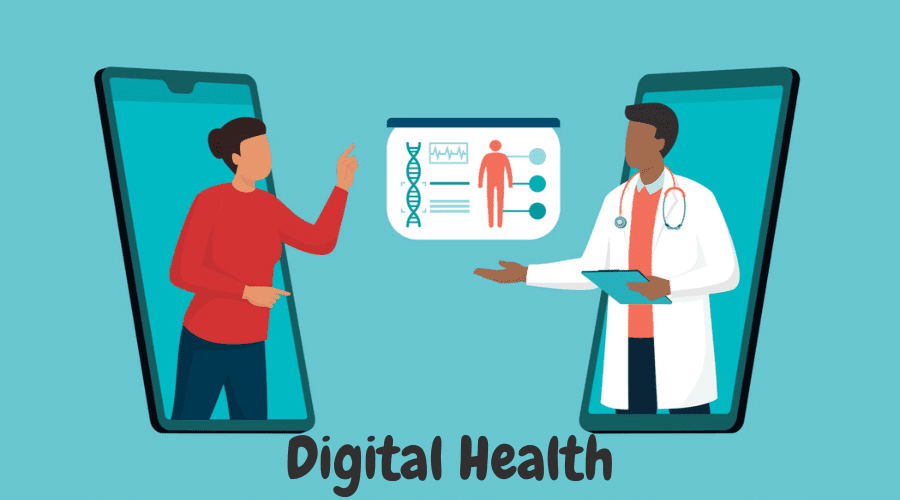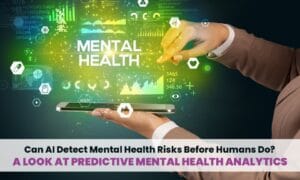
It comes as no surprise that the healthcare sector is witnessing a dramatic transition as a result of the incorporation of digital health in an age where technology is transforming every aspect of our lives. This cutting-edge strategy incorporates a variety of technologies, including wearables, telemedicine, AI-driven diagnostics, and health applications. We’ll delve into the field of digital health in this blog, looking at its roots, important advancements, effects on patient care, difficulties, and promising future prospects.
The Foundation of Digital Health
Defining Digital Health:
Digital health is fundamentally the integration of digital technologies with healthcare services in order to increase clinical outcomes, enhance patient experiences, and streamline the delivery of healthcare. This covers a wide range of technological advancements, all of which have helped contemporary healthcare advance.
Evolution and Historical Context:
The early adoption of electronic health records (EHRs) in the 1960s is where the roots of digital health can be found. However, the arrival of the internet and mobile technology, which opened the door for telehealth and health-related apps, marked the actual paradigm change. Due to the widespread use of smartphones and sophisticated data analytics during the past ten years, the advancement of digital health has accelerated.
Role of Technology:
The breakthroughs in digital health are driven by technology. These technologies, which range from artificial intelligence (AI) and machine learning to cloud computing and the Internet of Things (IoT), offer the framework for gathering, processing, and utilising healthcare data in novel ways.
Key Technologies Driving Digital Health
Telemedicine and Telehealth Platforms:
Healthcare practitioners can consult patients remotely thanks to telemedicine. This has proven to be quite helpful in circumstances where physical presence is difficult, such during a pandemic. Without having to leave their homes, patients can receive professional medical advice that will hasten diagnosis and treatment.
Wearable Devices and Health Trackers:
Smartwatches and fitness trackers are examples of wearables that have served more than one purpose. They now keep track of physiological indicators, sleep patterns, and physical activity to give consumers individualised health information. This information acts as an early warning system for future health problems and assists people in making well-informed lifestyle decisions.
Health Apps and Platforms:
For handling chores related to managing health, mobile applications have become essential. They make it easier for consumers to make appointments, get prescriptions, and access their medical records. Additionally, specialised apps address a range of health requirements, including managing mental health, women’s health, and tracking fitness.
AI and Machine Learning in Diagnostics:
Medical imaging has undergone a revolution thanks to AI-powered diagnostic technologies. Deep learning algorithms are remarkably accurate at spotting anomalies in X-rays, MRIs, and CT scans. This speeds up the diagnosis procedure and lowers the possibility of human error.
1. Telemedicine and Telehealth Platforms:
Describe telemedicine. Telemedicine is the practice of providing healthcare remotely, enabling patients to communicate with medical specialists by text, audio, or video. Particularly during the COVID-19 epidemic, when in-person consultations were difficult, this technology has become increasingly popular.
Benefits:
Accessibility: Telemedicine eliminates geographic limitations, enabling people in isolated or underdeveloped locations to receive medical knowledge.
Convenience: Patients no longer need to leave their homes for medical consultations, which cuts down on travel time and waiting.
Efficiency: Healthcare providers may provide consultations more quickly, which would speed up diagnosis and treatment.
Continuity of Care: Even when they are unable to see their doctors in person, patients can continue to regularly check in with them online.
Examples: Patient-provider virtual connections have grown in popularity thanks to websites like Teladoc, Amwell, and Doctor on Demand.
2. Wearable Devices and Health Trackers:
Wearable gadgets: What are they? Devices like smartwatches, fitness trackers, and health monitoring equipment are included in the category of wearables. These on-body tracking gadgets gather information about the user’s activity and health.
Benefits:
Real-Time Monitoring: Wearables provide a complete picture of one’s health by continuously monitoring vital signs including heart rate, blood pressure, and sleep habits.
Preventive Care: Users gain insights about their health-related behaviours, enabling them to adjust their lifestyles for the better.
Personalized Recommendations: Wearables offer individualised health advice and goals using the data they have collected.
Remote Patient Monitoring: Healthcare professionals can remotely check on their patients’ health and take action as needed.
Examples: Fitbit, Apple Watch, and Garmin are well-known brands producing wearable health devices.
3. Health Apps and Platforms:
How do I use a health app? Mobile applications called “health apps” are made to assist users in managing several facets of their health and wellness. These apps might include everything from medication management tools to fitness and nutrition trackers.
Benefits:
Convenience: Health-related tasks like appointment scheduling, prescription refills, and symptom tracking are centralised by health applications.
Education: Numerous apps offer users knowledge about ailments, cures, and good practises.
Personalized Tracking: Users may keep an eye on their health data, which helps them keep track of their development and make wise decisions.
Chronic Disease Management: By offering medication reminders and lifestyle advice, specialised applications assist people in managing chronic diseases.
Examples: MyFitnessPal, Medisafe, and WebMD are examples of popular health and wellness apps.
4. AI and Machine Learning in Diagnostics:
Healthcare with AI and Machine Learning (ML): ML and AI technologies have made substantial advancements in the field of medical diagnosis. Large databases are analysed by these technologies to find patterns and anomalies, enabling early disease identification and precise diagnosis.
Benefits:
Accurate Diagnoses: AI programs can examine medical images (such as X-rays and MRIs) and spot tiny anomalies that a human eye would miss.
Faster Results: Automated analysis shortens the time between tests and outcomes, accelerating the diagnostic procedure.
Predictive Modeling: By examining historical health data, AI can forecast illness trends and outbreaks.
Personalized Treatment: In order to develop individualised treatment plans based on genetics, medical history, and other aspects, AI analyses patient data.
Examples: IBM’s Watson for Health, Google’s DeepMind, and Aidoc specialize in AI-driven medical imaging analysis.
Together, these technologies change how healthcare is provided, accessed, and personalised, contributing to the digital health environment. These technologies are improving patient care, streamlining procedures, and advancing healthcare into the future by offering accessible medical consultations and empowering people to manage their own health through wearables and applications.
Transforming Patient Care
Accessibility to Healthcare Services:
Access to healthcare is no longer limited by geography thanks to digital health. Now, underserved and rural communities can gain from medical expertise that may not be present nearby. This guarantees better inclusiveness and equity in access to high-quality healthcare.
Patient Empowerment and Engagement:
Patients now actively participate in their treatment and are no longer just passive beneficiaries of it. Patients are able to make knowledgeable decisions about their health because to the complete information provided by digital resources regarding diseases, therapies, and medications.
Remote Monitoring and Chronic Disease Management:
Digital health has changed the game for those with chronic diseases. Doctors can check their patients’ health continuously using wearables and remote gadgets. This proactive approach improves patient quality of life while lowering hospital readmissions.
Challenges and Considerations
Data Privacy and Security:
While there are many advantages to digital health, it also raises questions about the security and privacy of private medical data. To protect patient data, healthcare providers and IT firms must abide by stringent laws like HIPAA (Health Insurance Portability and Accountability Act) and GDPR (General Data Protection Regulation).
Technological Barriers for Older Adults:
Even older people are not all equally skilled at using technology. Seniors must be able to use digital health resources without feeling overwhelmed, therefore user-friendly design and accessible interfaces are essential.
Integration with Traditional Healthcare Systems:
Integration with current healthcare systems is necessary for the transition to a digital health landscape. In order to provide seamless data sharing between healthcare providers, this entails establishing compatibility between various software platforms.
Future Prospects of Digital Health
Advancements in AI-Driven Diagnostics:
The use of AI in healthcare will only increase. While personalised treatment plans based on genetic data hold the possibility of more potent and tailored medicines, predictive modelling can help detect illness outbreaks.
Virtual Reality and Augmented Reality in Healthcare:
Medical teaching and patient care are now using VR and AR technologies. Patients who participate in immersive experiences can manage their pain and anxiety while medical personnel can practise intricate operations in controlled settings.
Blockchain Technology for Health Data Management:
Health data management could be completely transformed by blockchain’s secure and decentralised features. Electronic health records can be controlled by patients, and insurance claims and billing procedures can be made more open and effective.
Real-World Examples of Digital Health Success
Telemedicine in Rural Areas:
People who previously had little access to healthcare now have access to life-saving medical consultations thanks to telemedicine in distant areas. This has sped up interventions and produced better results.
Wearable Device Success Story:
Individuals have been able to actively manage their health thanks to continuous monitoring provided by wearable technology. By early spotting anomalies, for instance, improved heart rate monitoring has helped to avoid cardiac attacks.
AI-Powered Diagnostics:
Cancer detection demonstrates AI’s strength in diagnosis. In order to diagnose and cure cancer sooner, algorithms can analyse enormous volumes of medical data to find patterns suggestive of the disease.
Healthcare as we currently know it is changing due to digital health. technologies are enabling a revolution in medical treatment, from the practicality of telemedicine to the empowerment of patients through wearable technologies and AI-driven diagnostics. Even while issues with data privacy and integration continue, breakthroughs in AI, VR, and blockchain technology hold great promise for the future. We have the chance to bring in a new era of healthcare that is more individualised, accessible, and efficient as we accept these changes. Keep up with current events, be active, and be prepared to embrace the transformative potential of digital health.





